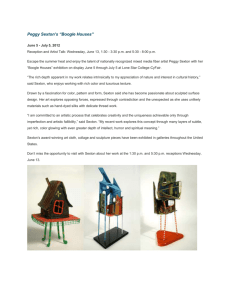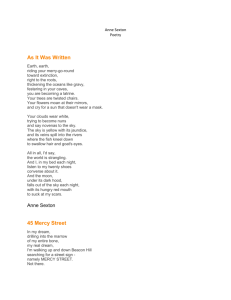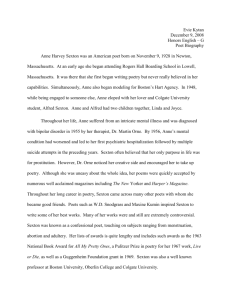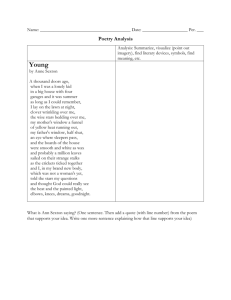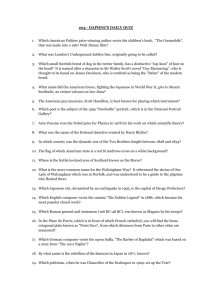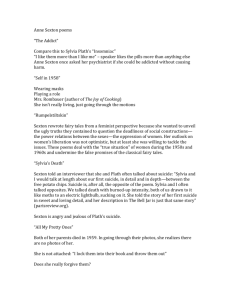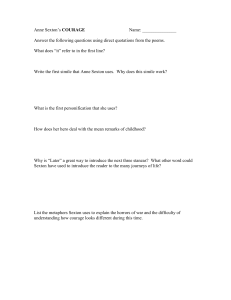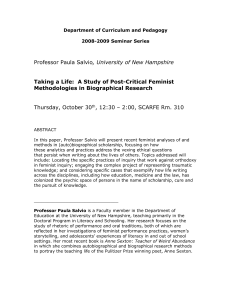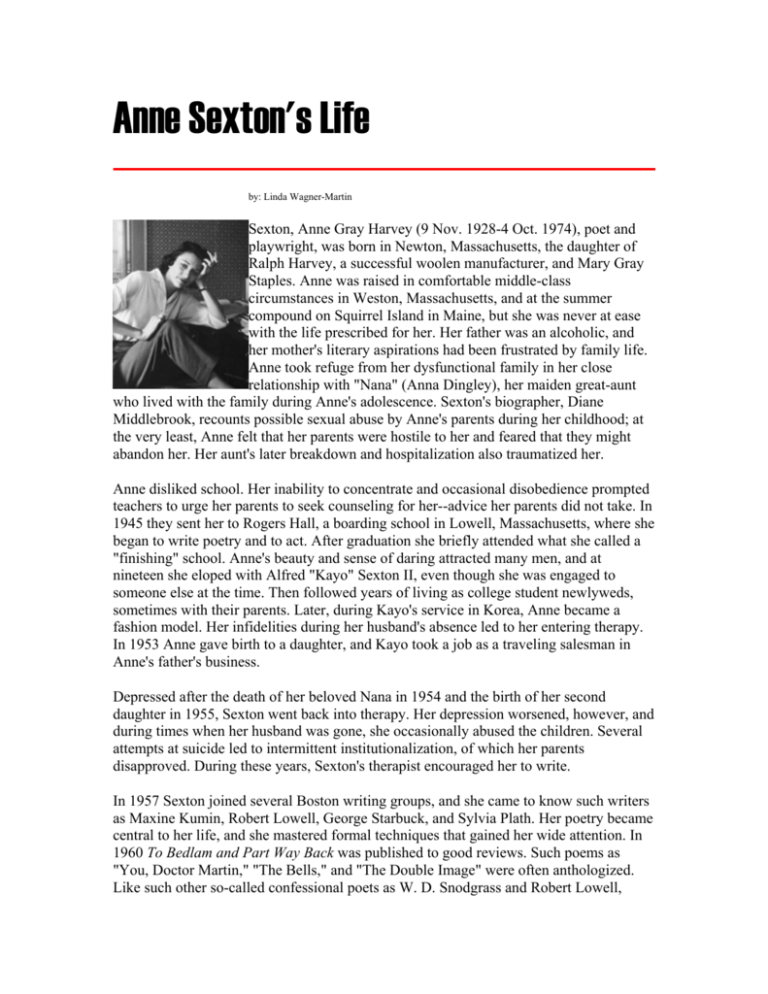
Anne Sexton's Life
by: Linda Wagner-Martin
Sexton, Anne Gray Harvey (9 Nov. 1928-4 Oct. 1974), poet and
playwright, was born in Newton, Massachusetts, the daughter of
Ralph Harvey, a successful woolen manufacturer, and Mary Gray
Staples. Anne was raised in comfortable middle-class
circumstances in Weston, Massachusetts, and at the summer
compound on Squirrel Island in Maine, but she was never at ease
with the life prescribed for her. Her father was an alcoholic, and
her mother's literary aspirations had been frustrated by family life.
Anne took refuge from her dysfunctional family in her close
relationship with "Nana" (Anna Dingley), her maiden great-aunt
who lived with the family during Anne's adolescence. Sexton's biographer, Diane
Middlebrook, recounts possible sexual abuse by Anne's parents during her childhood; at
the very least, Anne felt that her parents were hostile to her and feared that they might
abandon her. Her aunt's later breakdown and hospitalization also traumatized her.
Anne disliked school. Her inability to concentrate and occasional disobedience prompted
teachers to urge her parents to seek counseling for her--advice her parents did not take. In
1945 they sent her to Rogers Hall, a boarding school in Lowell, Massachusetts, where she
began to write poetry and to act. After graduation she briefly attended what she called a
"finishing" school. Anne's beauty and sense of daring attracted many men, and at
nineteen she eloped with Alfred "Kayo" Sexton II, even though she was engaged to
someone else at the time. Then followed years of living as college student newlyweds,
sometimes with their parents. Later, during Kayo's service in Korea, Anne became a
fashion model. Her infidelities during her husband's absence led to her entering therapy.
In 1953 Anne gave birth to a daughter, and Kayo took a job as a traveling salesman in
Anne's father's business.
Depressed after the death of her beloved Nana in 1954 and the birth of her second
daughter in 1955, Sexton went back into therapy. Her depression worsened, however, and
during times when her husband was gone, she occasionally abused the children. Several
attempts at suicide led to intermittent institutionalization, of which her parents
disapproved. During these years, Sexton's therapist encouraged her to write.
In 1957 Sexton joined several Boston writing groups, and she came to know such writers
as Maxine Kumin, Robert Lowell, George Starbuck, and Sylvia Plath. Her poetry became
central to her life, and she mastered formal techniques that gained her wide attention. In
1960 To Bedlam and Part Way Back was published to good reviews. Such poems as
"You, Doctor Martin," "The Bells," and "The Double Image" were often anthologized.
Like such other so-called confessional poets as W. D. Snodgrass and Robert Lowell,
Sexton was able to convince her readers that her poems echoed her life; not only was her
poetry technically excellent, but it was meaningful to the midcentury readers who lived
daily with similar kinds of fear and angst.
In 1959 Sexton unexpectedly lost both of her parents, and the memory of her difficult
relationships with them--so abruptly ended--led to further breakdowns. Poetry seemed the
only route to stability, though at times the friendships she made through her art, which
led to sexual affairs, also were unsettling. Her marriage was torn by discord and physical
abuse as her husband saw his formerly dependent wife become a celebrity.
In 1962 Sexton published All My Pretty Ones. So popular was her poetry in England that
an edition of Selected Poems was published there as a Poetry Book Selection in 1964. In
1967 Sexton received the Pulitzer Prize for poetry for Live or Die (1966), capping her
accumulation of honors such as the Frost Fellowship to the Bread Loaf Writers'
Conference (1959), the Radcliffe Institute Fellowship (1961), the Levinson Prize (1962),
the American Academy of Arts and Letters traveling fellowship (1963), the Shelley
Memorial Prize (1967), and an invitation to give the Morris Gray reading at Harvard. To
follow were a Guggenheim Fellowship, Ford Foundation grants, honorary degrees,
professorships at Colgate University and Boston University, and other distinctions.
Sexton's reputation as poet peaked with the publication of Love Poems (1969), an offBroadway production of her play Mercy Street (1969), and the publication of prose
poems in Transformations (1972). Clearly her most feminist work, the pieces in
Transformations spoke to a different kind of reader. The Sexton voice was now less
confessional and more critical of cultural practices, more inclined to look outside the
poet's persona for material. In 1963 Sexton had traveled in Europe, and in 1966 she and
Kayo had gone on an African safari. In 1970 she had helped him start a business of his
own after he broke associations with her father's former company. Contrary to her
seemingly confident public manner, however, Sexton was heavily dependent on
therapists, medications, close friends--particularly Maxine Kumin and, later, Lois Ames-and lovers. Continual depressive bouts, unexpected trance states, and comparatively
frequent suicide attempts kept her family and friends watchful and unnerved. Finally, in
1973, Sexton told Kayo she wanted a divorce, and from that time on a noticeable decline
in her health and stability occurred as loneliness, alcoholism, and depression took their
toll.
Estranged from many of her former friends, Sexton became difficult for her maturing
daughters to deal with. Aware that many of her readers did not like the religious poetry
that she had recently begun writing with her more personal themes, Sexton became
nervous about her poetry. Readings had always terrified her, but now she employed a
rock group to back up her performances. She forced herself to be an entertainer, while her
poems grew more and more privately sacral. In 1972 she published The Book of Folly
and, in 1974, the ominously titled The Death Notebooks. Later that year, she completed
The Awful Rowing toward God, published posthumously in 1975. Divorced and living by
herself, Sexton was lonely and seemed to be searching for compassion through love
affairs. She continued to be in psychotherapy, from which she evidently gained little
solace. In October 1974, after having lunched with Maxine Kumin, Sexton asphyxiated
herself with carbon monoxide in her garage in Boston.
Other posthumous collections of her poems include 45 Mercy Street (1976) and Words
for Dr. Y: Uncollected Poems with Three Stories (1978), both edited by Linda Gray
Sexton. The publication of Sexton's work culminated in The Complete Poems in 1981.
Sexton also wrote important essays about poetry and made insightful comments in her
many interviews. She understood the fictive impulse, the way the writer uses both fact
and the imagination in creation; and, like Wallace Stevens, she saw her art as the
"supreme fiction," the writer's finest accomplishment. Much of what Sexton wrote was in
no way autobiographical, despite the sense of reality it had, and thus criticisms of her
writing as "confessional" are misleading. She used her knowledge of the human
condition--often painful, but sometimes joyous--to create poems readers could share. Her
incisive metaphors, the unexpected rhythms of her verse, and her ability to grasp a range
of meaning in precise words have secured Sexton's good reputation. Though
comparatively short, her writing career was successful, as was her art.
Bibliography
Anne Sexton's papers are housed at the Harry Ransom Humanities Research Center,
University of Texas, Austin. The authorized biography is Diane Wood Middlebrook,
Anne Sexton: A Biography (1991), controversial in part because of the information
supplied by Sexton's first therapist. The major critical study is Diana Hume George,
Oedipus Anne: The Poetry of Anne Sexton (1987). Collections of criticism by various
critics are Diana Hume George, Sexton: Selected Criticism (1988); J. D. McClatchy,
Anne Sexton: The Artist and Her Critics (1978); Frances Bixler, Original Essays on the
Poetry of Anne Sexton (1988); Steven E. Colburn, Anne Sexton: Telling the Tale (1988);
and Linda Wagner-Martin, Critical Essays on Anne Sexton (1989).
Cameron Northouse and Thomas P. Walsh published Sylvia Plath and Anne Sexton: A
Reference Guide (1974), but no complete bibliography exists. Diane Wood Middlebrook
and Diane Hume George coedited Selected Poems of Anne Sexton (1988), and Linda
Gray Sexton and Lois Ames edited Anne Sexton: A Self-Portrait in Letters (1977). Steven
E. Colburn edited No Evil Star: Selected Essays, Interviews and Prose (1985), a
collection of Sexton's previously published prose.
Source: http://www.anb.org/articles/16/16-01490.html ; American National Biography
Online Feb. 2000. Access Date: Sun Mar 18 18:01:55 2001 Copyright (c) 2000 American
Council of Learned Societies. Published by Oxford University Press. All rights reserved.
The Addict
Anne Sexton
Sleepmonger,
deathmonger,
with capsules in my palms each night,
eight at a time from sweet pharmaceutical
bottles
I make arrangements for a pint-sized
journey.
I'm the queen of this condition.
I'm an expert on making the trip
and now they say I'm an addict.
Now they ask why.
WHY!
Don't they know that I promised to die!
I'm keping in practice.
I'm merely staying in shape.
The pills are a mother, but better,
every color and as good as sour balls.
I'm on a diet from death.
Yes, I admit
it has gotten to be a bit of a habitblows eight at a time, socked in the eye,
hauled away by the pink, the orange,
the green and the white goodnights.
I'm becoming something of a chemical
mixture.
that's it!
My supply
of tablets
has got to last for years and years.
I like them more than I like me.
It's a kind of marriage.
It's a kind of war where I plant bombs inside
of myself.
Yes
I try
to kill myself in small amounts,
an innocuous occupatin.
Actually I'm hung up on it.
But remember I don't make too much noise.
And frankly no one has to lug me out
and I don't stand there in my winding sheet.
I'm a little buttercup in my yellow nightie
eating my eight loaves in a row
and in a certain order as in
the laying on of hands
or the black sacrament.
It's a ceremony
but like any other sport
it's full of rules.
It's like a musical tennis match where
my mouth keeps catching the ball.
Then I lie on; my altar
elevated by the eight chemical kisses.
What a lay me down this is
with two pink, two orange,
two green, two white goodnights.
Fee-fi-fo-fumNow I'm borrowed.
Now I'm numb.
Wanting to Die
by Anne Sexton
Since you ask, most days I cannot remember.
I walk in my clothing, unmarked by that voyage.
Then the almost unnameable lust returns.
Even then I have nothing against life.
I know well the grass blades you mention,
the furniture you have placed under the sun.
But suicides have a special language.
Like carpenters they want to know which tools.
They never ask why build.
Twice I have so simply declared myself,
have possessed the enemy, eaten the enemy,
have taken on his craft, his magic.
In this way, heavy and thoughtful,
warmer than oil or water,
I have rested, drooling at the mouth-hole.
I did not think of my body at needle point.
Even the cornea and the leftover urine were gone.
Suicides have already betrayed the body.
Still-born, they don't always die,
but dazzled, they can't forget a drug so sweet
that even children would look on and smile.
To thrust all that life under your tongue!-that, all by itself, becomes a passion.
Death's a sad Bone; bruised, you'd say,
and yet she waits for me, year after year,
to so delicately undo an old wound,
to empty my breath from its bad prison.
Balanced there, suicides sometimes meet,
raging at the fruit, a pumped-up moon,
leaving the bread they mistook for a kiss,
leaving the page of the book carelessly open,
something unsaid, the phone off the hook
and the love, whatever it was, an infection.

